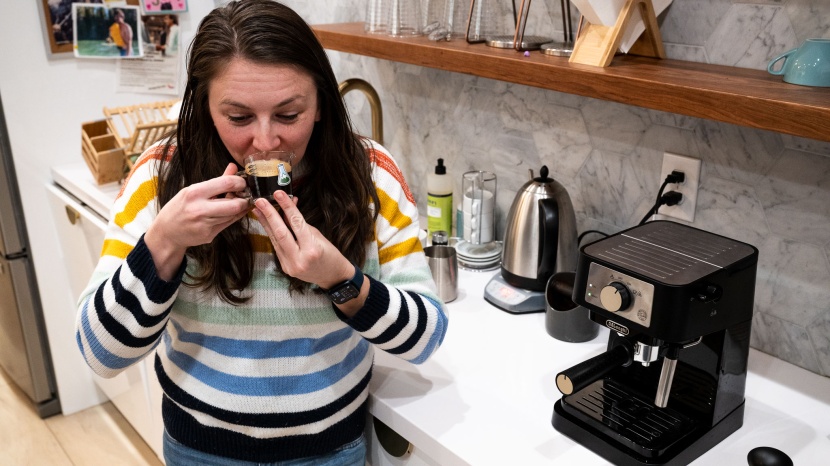The best home espresso machine makes great-tasting espresso with rich crema, quickly steams milk into luscious microfoam, and is simple to use. With those bases covered, you'll want to jump out of bed for your morning latte and leave far less money at your favorite coffee shop. We combined the expertise of our best testing experts with an in-house professional barista and spent countless lab hours testing each of these machines side by side. Our in-depth examinations focused on five key metrics: Espresso Quality, Ease of Use, Ease of Cleaning, Milk Steaming, and Machine Customization. We hope our findings help you make the best choice as you search to add an espresso machine as your next kitchen appliance.
Espresso Quality
Taste is very subjective, so we recruited a diverse set of palates for our taste tests and teamed them up with a food science expert and professional barista with over a decade of experience. We wanted to ensure we got opinions from people who aren't particularly fussy about their coffee, as well as from those who enjoy detailing every nuance of their espresso experience. Then, we systematically brewed shots from each machine using 19 grams of grounds (though a few machines could not accommodate this amount) and tested our results in consecutive order.
We pulled espresso from each machine, using the same coffee beans across the board. We made sure each shot was fresh so that each espresso was at its optimal taste level. This practice prevented skewing of the results by shots sitting that sat around stagnating. Our testers were asked to note the overall balance (bitter vs sweet) and the density (thick vs watery) of each shot. They also noted any other noticeable characteristics like acidity or smoothness. During the process, our experts made note of each unit's extraction time and recorded their thoughts on the visual appearance of each shot, particularly the quality, color, and texture of the crema.
Lastly, we employed a refractometer to see how each shot competed on a microscopic level. This device helped us determine the extraction yield each machine was able to produce. A refractometer uses light to determine the total dissolved solids (TDS) in liquid. In the case of espresso, TDS basically shows how much coffee left the puck and then made it through the filter basket into the shot glass. Another way of saying it is: How much coffee is actually in your coffee? Our food science experts took a sample of each shot, analyzed it with the refractometer, and applied the TDS reading to some basic math. The math equation took into account the grams of coffee grounds and the total grams of liquid espresso produced. The sum of it all is what coffee aficionados call extraction yield. Industry standards for espresso are 18 to 22%.
Ease of Use
Our testers made hundreds of espresso shots in our testing lab. Thus, we gained a very intuitive feel of how easy or difficult each one of our machines was to use. Throughout the process, we took careful notes on each machine's initial setup and general design. Finally, we performed a cappuccino time trial for each machine. We started the clock when we began and stopped the clock when the drink was ready. This method gave us a definitive measure of the fastest machines. This info will be most helpful for those in a hurry in the morning.
Ease of Cleaning
The lab was akin to a bustling cafe during testing. In the midst of this hubbub, there also was a lot of kitchen duty, giving us plenty of opportunities to clean each espresso machine thoroughly. We split our ease-of-cleaning evaluation into three submetrics — daily cleaning, weekly cleaning, and descaling (essentially long-term cleaning). Our daily cleaning evaluation focused on the things that need cleaning after each use, namely portafilters and steam wands. Weekly cleaning looked at things like drip tray maintenance and system flushes. Finally, descaling — a process completed every few months to remove any mineral buildup — was performed by our testers on each machine. We took careful notes on how this process differed between machines and the demands the process placed on the user.
Milk Steaming
Our milk steaming evaluation mostly focused on microfoam production and steam wand consistency. As with the espresso quality evaluation, we set the bar high. Machines that could produce foam on par with a professional coffee shop earned the highest scores. The texture of the milk is key when it comes to microfoam. Accordingly, we looked for the right size bubbles in the milk (quality foam will pour like paint) and assessed the foam for velvety mouthfeel. We also looked at the foam's temperature and assessed its consistency. More specifically, we checked the steam wand's temperature and the pressure of the steam it produced. Finally, we assessed the wand's ease of use.
Machine Customization
The best espresso machines give the user the ability to experiment and customize. During this evaluation, we examined each machine's ability to adjust heat and pressure. We also awarded points to espresso machines that offer a pre-infusion option, which pre-soaks the puck with water prior to placing it under the full pressure of the infustion process. Machines that were generous in their ability to pull different sizes of shots were also high on our list. Lastly, manually operated machines — that rely more on user skill and experience than automated processes — allow for infinite customization of heat, pressure and time. These machines have a much higher learning curve but still received some of our highest scores for their versatility.
Conclusion
We spent several weeks in the lab testing each machine individually and side by side. We documented our research and scored each machine comparatively to show us how they directly compete against each other in our five metrics. Espresso machines are complicated. Each has its own quirks; however, through our extensive testing, we feel we've effectively detailed the pros and cons of each model in hopes of helping you narrow down your shortlist, purchase the machine that is best for you, and start enjoying lattes at home.



